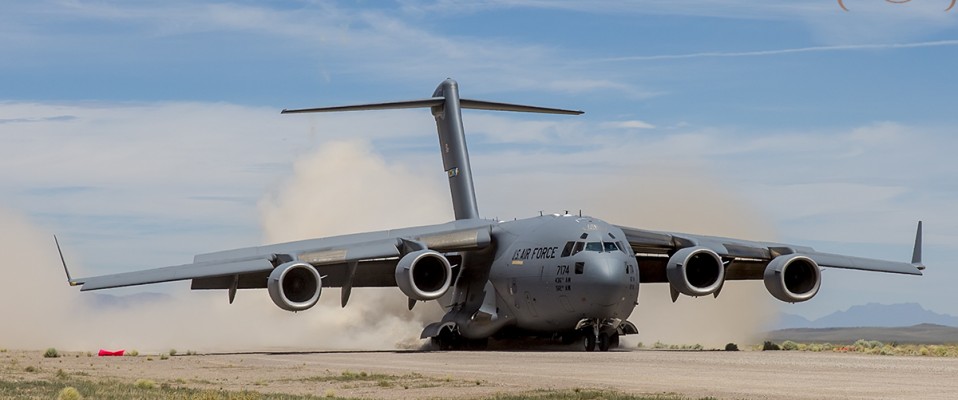Joint Forcible Entry – Making of the Advanced Integration WarFighter
Personal insights from the Warfighters planning and executing the exercise
Aviation Photography Digest was granted the opportunity to observe JFEX (6-18-16) and interview the Commandant of the USAF Weapons School, Col. Michael “Johnny Bravo” Drowley, and Weapons School Instructors, Maj. Chris “Hobo” Lawler (JFE Exercise Lead, C-17 pilot) and Capt. Andrew “Caddy” Standeford (C-130 pilot).
Photos by Eric Bowen and Todd Miller
July 13, 2016
The adversaries unimproved landing strip is well protected by advanced Surface to Air Missile (SAM) systems, sophisticated tracking radars, electronic countermeasures, high altitude missile batteries and dynamic ground threats all working in concert with a capable air force. It is the classic definition of an Anti-Access/Area Denial (A2/AD) environment.
In this case, not an area to be circumvented, rather one to be neutralized and entered. The mission, deliver the US Army’s 82nd Airborne Division to the airfield by air and land (air drop paratroopers and land and offload support equipment). The Joint US Aerial Force will utilize a wide variety of specialized “platforms” to knock down the door and immobilize the adversary so the transport aircraft can deliver the army.

Air Mobility Command C-17A of the 437 AW/315 AW, Charleston, SC launches flares over Keno Airfield on the NTTR during Joint Forcible Entry Exercise (Dec. 2015).
This is the Joint Forcible Entry exercise (JFE, or JFEX), a realistic training exercise within a very sophisticated A2/AD environment. JFE takes place twice a year as one of the final “vuls” (short for “vulnerability period” – a term used by the Air Force similar to how the general public might use “mission”) prior to graduation for students of the U.S. Air Force Weapons School (USAFWS). The “students” are actually tremendously accomplished instructors on their particular platform, many with a number of tours.
On our fourth pass we released the ammo and at about the same time the guys on the ground called out ‘RPG'”You cannot replicate the kind of real world experience described by Maj. Chris Lawler a C-17 pilot. Serving in Afghanistan during the winter of 2010 would provide Lawler with a mission he would not forget. “Returning to base from a sustainment drop we were tasked with an emergency airdrop. It was an urgent task, ‘Troops in contact!’ at a forward operating base (FOB) in northwestern Afghanistan. The troops were in an intense firefight and they were running low on ammunition. We landed at base and loaded the ammunition immediately and headed towards the FOB. The terrain was high and unforgiving and the weather was poor with plenty of broken clouds. Darkness had fallen, and given the steep terrain we could not get below the clouds to make the drop the way we preferred.
We executed a tactic we call ICDS (improved Container Delivery System). We make a pass and drop a “sonde” that passes us wind information and allows us to drop more accurately from a higher altitude. First pass back over the target the data was not yet calibrated and we could not make the drop. We came back around over the very small cargo landing zone (LZ). The guys on the ground waved us off because the area was so tight they were concerned the pallets of ammunition would land right on them. They called and asked to adjust drop area – I could not. ‘If you want your ammunition, this is where it has to go.’ We came back around again and they waved us off again.”
The Air Force Opportunity
- The level of innovation and leadership exposure that people receive when they come into the Air Force is top notch. It’s a great foundational if you want to stay and continue that leadership development. If you want to separate or transition, I know it’s going to set a person up to be successful. The Air Force challenges its young Captains (such as Mission Commander for the JFE, Maj. Lawler) to go forth and conquer problem sets. Where else can a young person get that level of empowerment, that level of mastery?
- The Air Force wants you to be the best at your job and provide whatever it takes to help you to be that best. We want to give you the resources, the time, the control. That’s really what we’re looking for here at Weapons School, we want Airman to be masters of their craft.
- The last component the Air Force offers is purpose, serving something that’s greater than yourself. Whether on an Airlift bringing humanitarian aid into a country that needs it, whether an A-10 guy providing close air support for an 18 year old with a rifle that’s taking fire, or whether a bomber pilot who goes and via a show of force to a particular country is going to stop them making noise – those in the Air Force are always doing something that’s bigger than themselves.
Col. Michael Drowley Commandant of the USAF Weapons School
Making that many passes makes one a target of opportunity for the enemy. “On our fourth pass we released the ammo and at about the same time the guys on the ground called out “RPG”! We were engaged by an RPG (rocket propelled grenade) as well as heavy machine gun from a nearby location. We immediately reacted defensively so that we were able to safely egress from the area. Come to find out, one of my LoadMasters at the ramp was filming with night vision and you can see all the tracers incoming. That was probably the most exciting and rewarding singular mission I have flown. It was great knowing that in spite of difficult conditions and contact with enemy we were able to execute and get the guys on the ground the supplies they needed.”
Lawler would return from Afghanistan and become a Weapons School “student” in 2012. Beyond piloting expertise, Weapons School students have shown themselves to be leaders among peers.
The first months of the Weapons School provide a Ph.D. level of instruction on the student’s particular platform. The final portion of the course includes intense instruction on all the available platforms and their specific capabilities – including space, cyber and electronic warfare. The goal for Weapons School graduates – that they will be advanced integration warfare specialists.
Commandant of the USAF Weapons School, Col. Michael Drowley explains, “It’s just not enough to be that platform expert, you have to be an expert across all capabilities. So the F-16 pilot has to know how Cyber is enabling their mission. He/She has to know how the Space domain is coming into play to help get the objectives that the Combined Forces Air Component (CFAC) and our combat commanders need. At the same time the B-52 pilot needs to know how their effects are either helping or hindering those other capabilities as well. It’s not enough to be able to manipulate your platform very, very well. A student has to know how their platform integrates across all combat specialties and then helps get to those objectives that have been laid out for us. The foundation underneath all of that is leadership. It comes down to the ability to walk into a room that is a mix portfolio of Air Force and Joint specialties and lead the mission planning cell to a successful outcome.
If you strive to be the best at your craft, and your craft is aerial warfare, the USAF Weapons school is clearly the pinnacle of learning and achievement.

Colonel Michael “Johnny Bravo” Drowley, Commandant of the USAF Weapons School, stands in front of memorabilia recognizing his expertise as A-10 pilot.
Drowley notes, “The Air Force is being asked to go after more difficult, and dynamic targets. The targets are very mobile and peer or near-peer adversaries are trying to protect those targets in A2/AD environments. We have fewer fighter and bomber aircraft than at the high points of Desert Storm and previous. Graduates are facing more difficult problems with a smaller force size and the only way to be successful is to integrate across all of the available capabilities.
The Nevada Test and Training Range (NTTR) provides the ideal venue for the exercise. The massive, restricted air and ground space of the NTTR features advanced radar systems, surface to air missile sites (SAM), stationary ground targets, dynamic targets as well as the unimproved Keno airfield. These systems are configured to create the most challenging and realistic A2/AD threat. Maj. Lawler explains, “It’s the biggest piece of air space with the most sophisticated and realistic replication of threats anywhere in world. So the fact that as aircraft are flying in, onboard sensors are telling crews that there’s something lethal out there that wants to kill them (even though there’s not going to be a real missile flying) it still makes the hair on the back of their neck stand up and makes everybody operate at the highest level.”
The Objective
Planning and preparation for JFE starts as early as a year prior. However, the weapons students are given the “mission objective” just a couple days prior to execution. It takes students 10-12 hours to assess challenges, resources, and create a mission plan with rules of engagement (ROE), contracts and contingencies.
The JFE objective: Achieve an air and land drop of US Army paratroopers (82nd Airborne Division) and equipment on an unimproved airfield within contested space (an A2/AD environment protected by a capable “Red Air Force”).
The friendly or “Blue” force consisted of a Mobility Air Force (MAF) of 21 C-17As and 18 C-130H&Js and a Combat Air Force (CAF) of 33 aircraft including 9 platforms (F-16CM, F-15C, F-15E, EA-18G, B-52, A-10, E-3, RC-135J, E8, MQ-9). The CAF objective: Create lanes and push back the adversary forces so the MAF can safely ingress to the airfield and make their drops. Airborne Command and Control (C2) capabilities were complemented by Joint Terminal Attack Controllers (JTACs) on the ground in the vicinity of the airfield.
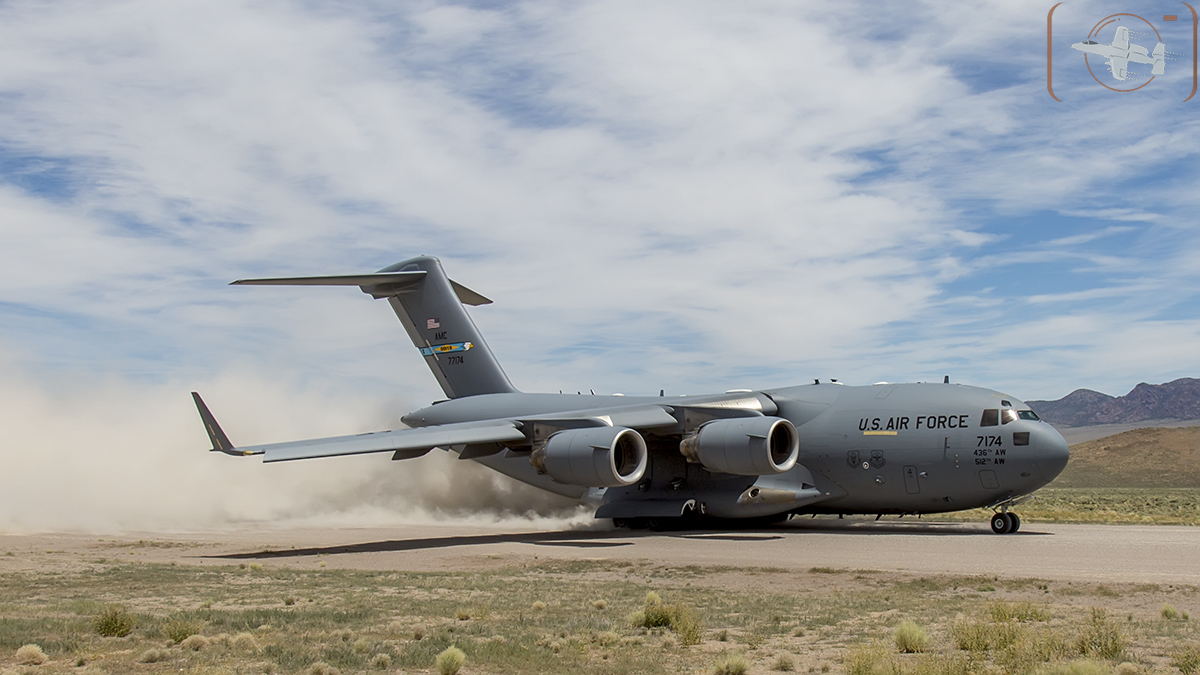
Air Mobility Command C-17A of the 436th Airlift Wing, Dover, DE takes off in crosswind at Keno Airfield on the NTTR during Joint Forcible Entry Exercise (June 2016).
The adversary or “Red” force included 10 aircraft (8 F-16s and 2 A-4s) that integrated with an extensive ground force: integrated air defense system (IADS), surface to air missiles (SAMs), dynamic targets (including SAM sites), Cyber, Electronic Warfare, ground vehicles with heavy and light weaponry, and U.S. Army High Mobility Artillery Rocket Systems (HIMARS).
Capt. Andrew Standeford emphasized the joint aspect of the exercise: “What the Air Force is doing is here is supporting the army because that’s the end game, getting the Army on the ground allowing them to execute their objectives once they get on the ground.”
The JFE exercise involved 82 aircraft and just under 600 personnel.
The Mission Briefing
Drowley notes how difficult it is for the mission planners to perform the short briefing: “The mission planning needs to bring in all the aircrews who have had no exposure to the mission planning and really take them from zero to sixty in one hour. Those participants need to know the plan as well as everybody that mission planned for twelve hours, including all the options, contingencies and reasons why we’re going to perform specific actions in order for everybody to be successful.”
Aside from the “layered” Blue CAF, it was no small task to coordinate the arrival of the MAF, 21 C-17s and 18 C-130s into airfield airspace.
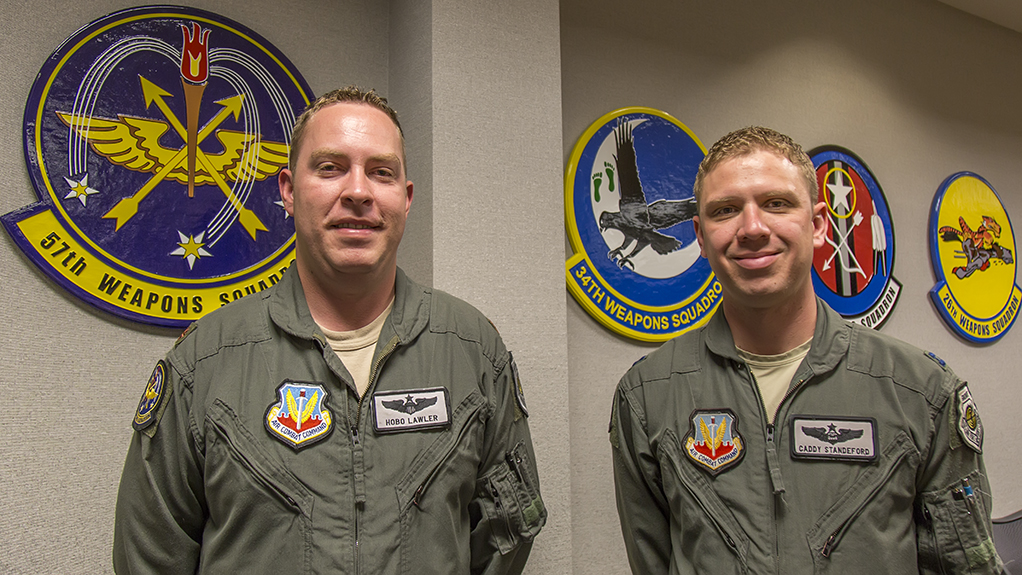
USAF Weapons School Instructors, Maj. Chris Lawler (57th Weapons Squadron, McGuire AFB C-17 pilot and JFE 2016-A Exercise Lead) and Capt. Andrew Standeford (29th Weapons Squadron, Little Rock AFB C-130 pilot)
Lawler explains, “The first layer of the plan is how are we going to deconflict from each other. Once that piece is figured out then we take a look at how we will deconflict from the other Blue Air players that are out there. And then, how do we deconflict once the enemy gets the threats active and we start deviating from the original plan. It’s a multilayered approach of deconfliction that the planners go through. It’s a lot of information for pilots to absorb. Once they go into execution they are focusing on what the planners have given them for each phase of flight.”
Communication
Communication is one of the key learning components of the exercise. Drowley states, “if somebody has the situational awareness to realize this is [may be] the one key that everybody needs, it’s their responsibility as a leader to key the mike. They have to get that information out to pull assets together, to execute correctly in order to negate what the enemy is trying to do to them. Many of the lessons learned that come out of the debrief are about communication. Somebody knew a piece of information, was leadership exercised to ensure it got disseminated out to everybody?”
Data feeds from Remotely Piloted Aircraft (RPA), the E-8 JSTARS, RC-135 Rivet Joint, E-3 AWACS and space assets create a tremendous amount of information that must be assessed and acted on in real time. Each platform is challenged to communicate the relevant data, at the right time – even as time is of the essence for vulnerable transports are inbound.
We take realistic world problems from the some of the potential adversaries and we give them a booster shot of steroids and make them even more difficult.”
Communication starts with the defined “rules of engagement” (ROE) and the subsequent “contracts” that each platform or flightcrew agree to execute too. For example, in this particular exercise the A-10s were given a block of airspace around the airfield up to a specific altitude. Within that space, they were “weapons free” to engage and neutralize what were deemed as threats. Within the context of ROE and “contracts” individual aircrews have autonomy to act to protect their aircraft, and accomplish the objective.
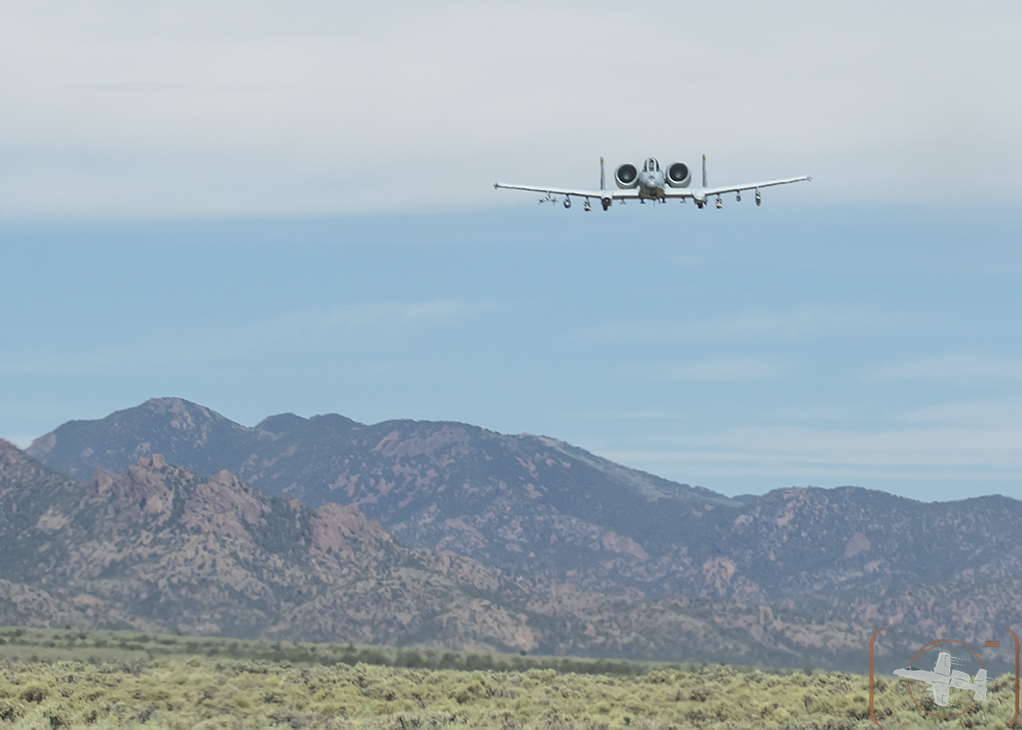
A-10C of the 66 WPS, Nellis AFB makes a head on pass on our convoy as we move towards Keno Airfield on the NTTR during JFEX. The A-10C offered close air support in the immediate victinity of the airfield during the Joint Forcible Entry Exercise (June 2016).
Standeford commented on this communication/leadership philosophy as it related to the paratroop carrying C-130s: “On the C-130 side we like to pride ourselves on the decentralized execution. So each individual aircraft is their decision authority amongst themselves.” Every aircraft commander knows the parameters for the jump (airspeed, altitude etc.), as well as what and where they and everyone else is supposed to be. There is flexibility within the plan to deviate, for any number of reasons. They simply must communicate effectively so everyone understands the what and why.
The “Vul” in Contested Space
It’s “go” time, and Blue air CAF unleash a choreographed symphony of pain on the target area and surrounding defenses. Suppression of Enemy Air Defense (SEAD) Air to Air (A2A), Air to Ground (A2G), Offensive Counter Air (OCA), Intelligence, Reconnaissance, Surveillance (ISR) Close Air Support (CAS), Electronic Warfare (EW), Cyber, Space – a full spectrum force comes alive delivering blows from all sides.
Yet as Drowley explains the enemy is challenging and unpredictable: “The enemy gets a vote. Their aggressors, SAMs, the high value mobile targets are very much alive and very dynamic. Students walk out the door with the best plan that can be executed, but as soon as they get out there, the enemy on the range does not want their targets hit and does not want Blue air coming into their airspace. Now the students must adapt the plan that they came up. It requires strong leadership to see through all the fog and friction that’s presented out there, whether it’s the enemy doing it to us or sometimes us doing it to ourselves. To be able to see through all that and identify what needs to be done or changed to be successful is the ultimate test.”
Drowley adds, “It is great learning because these are very, very difficult problems that we’re presenting the students. We take realistic world problems from the some of the potential adversaries and we give them a booster shot of steroids and make them even more difficult. So that way the enemy they face here on the NTTR is ten times tougher than whatever they may face in the real world.”
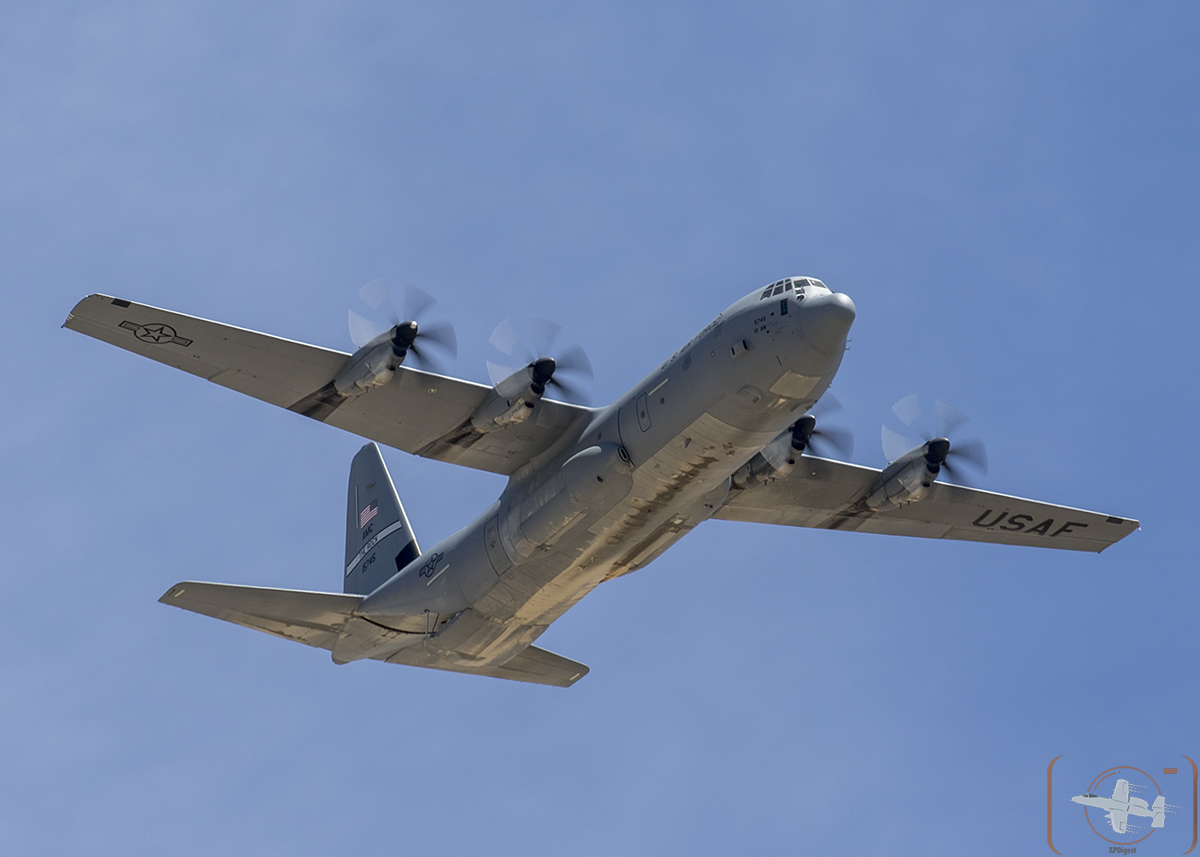
Air Mobility Command C-130J-30 of Little Rock AFB, AR overflies Keno Airfield on the NTTR during JFEX (June 2016). The “J’s” ramp is open as it prepares to drop U.S. Army paratroppers from the 82nd Airborne Division.
Even while the CAF initiates their attack, near 40 C-17s and C-130s are making their way from a number of locations around the country converging on a rally point for their ingress to Keno. It can’t be said better than Drowley expresses, “…they come from across the country, rejoin at a point and come into the range while this whole A2A and A2G battle is going on and they’re getting updates. When you think about the joint command and control it’s pretty impressive. There is a strike (A2G) and A2A Mission Commander trying to clear the lanes so they can come in and do the air drop. The MAF package commander is managing all the C17S and C130s as they come across the United States. In the back of the lead aircraft is the 82nd Airborne Division on scene Commander who’s about to jump out of the plane and take command of the battlespace from the ground. The 82nd Airborne Commander is getting updates on how Blue air is taking out Red air, SAMs and what threats are on the airfield. The C2 of the entire exercise is pretty phenomenal – a pure combat air component to a pure mobility component to the joint portion of the 82nd Airborne who are onboard the aircraft and then we have JTACs on the field for CAS. It really does bring together a tremendous amount of joint capabilities to be able to execute. And again, the problem that we are going against is not an easy one, we are bringing pretty vulnerable aircraft into a very contested environment.”
Throughout the JFE students must consider what constitutes a threat – and to whom. Drowley explains, “So for the A2A players Red air is a primary threat, it’s a primary threat to the C-17s and the C-130s that are on their way into the field. However, for the 82nd Airborne that’s jumping in, a five vehicle convoy is very threatening to them and so you really have the spectrum. A CAF platform does not see that convoy as much of a threat, however it’s a very real threat to the five or six guys that are in a parachute that are going to land in that vicinity. So you really have to be able to go from a wide macro view of taking in the SAMs and the Red air all the way to a very micro view of a five vehicle convoy that’s trying to get in and seize a part of the airfield and it needs to be neutralized.”
With primary air and ground threats neutralized, the force of C-17s and C-130s appeared over the field on cue. Some of the transport aircraft have flown direct to the central Nevada location from distances as far as Fort Bragg, NC, and Dyess AFB, TX.
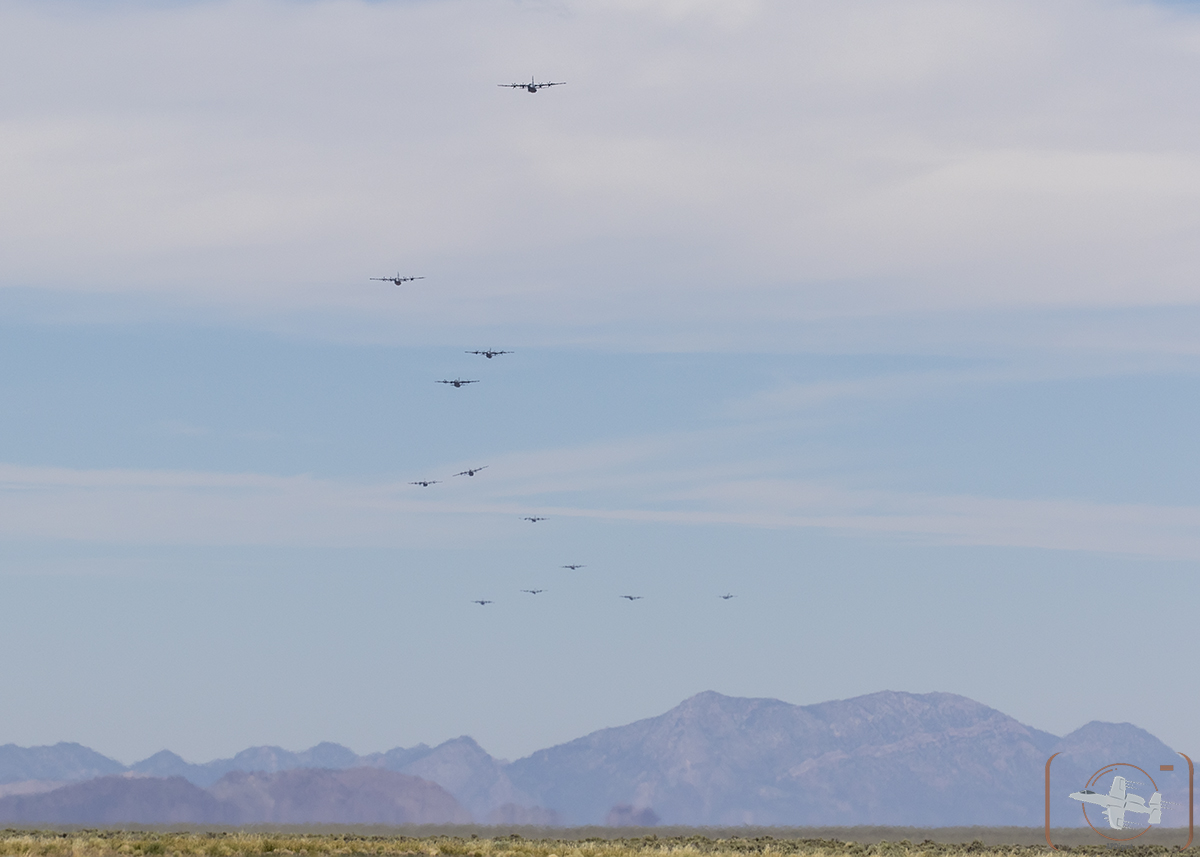
C-130H & Js incoming to Keno Airfield with paratroopers from the U.S. Army 82nd Airborne Division. The aircraft react to hostile threats as they prepare to make the drop on the NTTR during JFEX (June 2016).
A number of the C-17s and C-130s deviated from straight in approaches, their heavy banking, jinking and altitude shifts indicated threat warnings in the immediate proximity of the drop zone. That interruption of the MAF on airfield approach presented a collision hazard, but the mission planners and pilots had it in hand. Standeford explains the approach, “We always say, ‘Aviate, Navigate, Communicate.’ So first thing is to get the airplane where it needs to be, take care of yourself. Make sure you’re avoiding everybody else visually and then start getting back into position and communicating that to the fellow flights. For our students the big piece to alleviate conflict is how they communicate the plan that they’ve built for the last three or four days to those out based crews that weren’t sitting in and planning it. That’s a very key piece. Not only planning and having a solid plan, but being able to communicate that plan. When things start falling out and aren’t going as planned they have a full understanding of what’s expected of them and it is more of a reaction versus something they have to think about.”
The MAF crews narrow their focus to the “drop zone” and required approach profile even as their eyes sweep the ground looking for threats. A rocket is launched and a small vehicle convoy is spotted incoming to the field. A quick word on the radio, and C2 directs the nearest available weapons platform to the threat. Within seconds an A-10 whistles past bobbing and weaving, rolls up, and banking hard puts its 30mm GAU-8 on target, and we imagine the BRRRRTTTT! Threat…. neutralized. Throughout the operation, A-10s remained low and close to the airfield while F-16CMs, F-15C & Es and B-52s circled high overhead responding to ongoing SAM and air threats.
Debriefing
Once the exercise is complete those monitoring from Nellis AFB meet to validate missile shots that have been “tracked” electronically. Kills and misses from both sides are identified so the learning is elevated. Drowley unpacks the nature of the debrief: “…here’s what you did wrong, here’s what you did right. We need them (debriefers) to punish our mistakes so that we can learn. They give a very accurate representation and then they give us phenomenal feedback on what was successful and what was unsuccessful so we can learn from it.”
For the Weapons School “students” it is never just about the exercise. It is about learning lessons that they can share with the rest of the Air Force to help all be successful in this environment.
The C-130 has only six pallet positions, but you look into that cargo hold and all you see is one casket draped with an American flag.”
The Future of JFE and the Weapons School
Given that warfare is evolving rapidly, and cyber and the space domain can be considered components of A2/AD, the range and training exercises are challenged to evolve to a higher state. It begs the question of how committed the Department of Defense is to funding range development as well as how the Air Force and the Weapons School can create a realistic training environment moving forward. Drowley comments, “The range (NTTR) gives us great capability, it is the crown jewel of training facilities. And we want to make sure that it is always sharpened and refined to give us the best presentation possible.”
The time to “practice and refine TTPs” is prior to war – not during. The F-22 and F-35 provide an entirely new level of information to the warfighter, and it will be a challenge to determine how best to disseminate. Full spectrum capabilities give Commanders the opportunity to consider a number of potential effects (kinetic and non-kinetic) on a “target” with a wide number of outcomes. Replicating those effects, and the fusion of information within a training exercise is an evolving process. The Live Virtual Constructive (LVC) training environment is emerging as the critical training methodology to encompass these new capabilities.
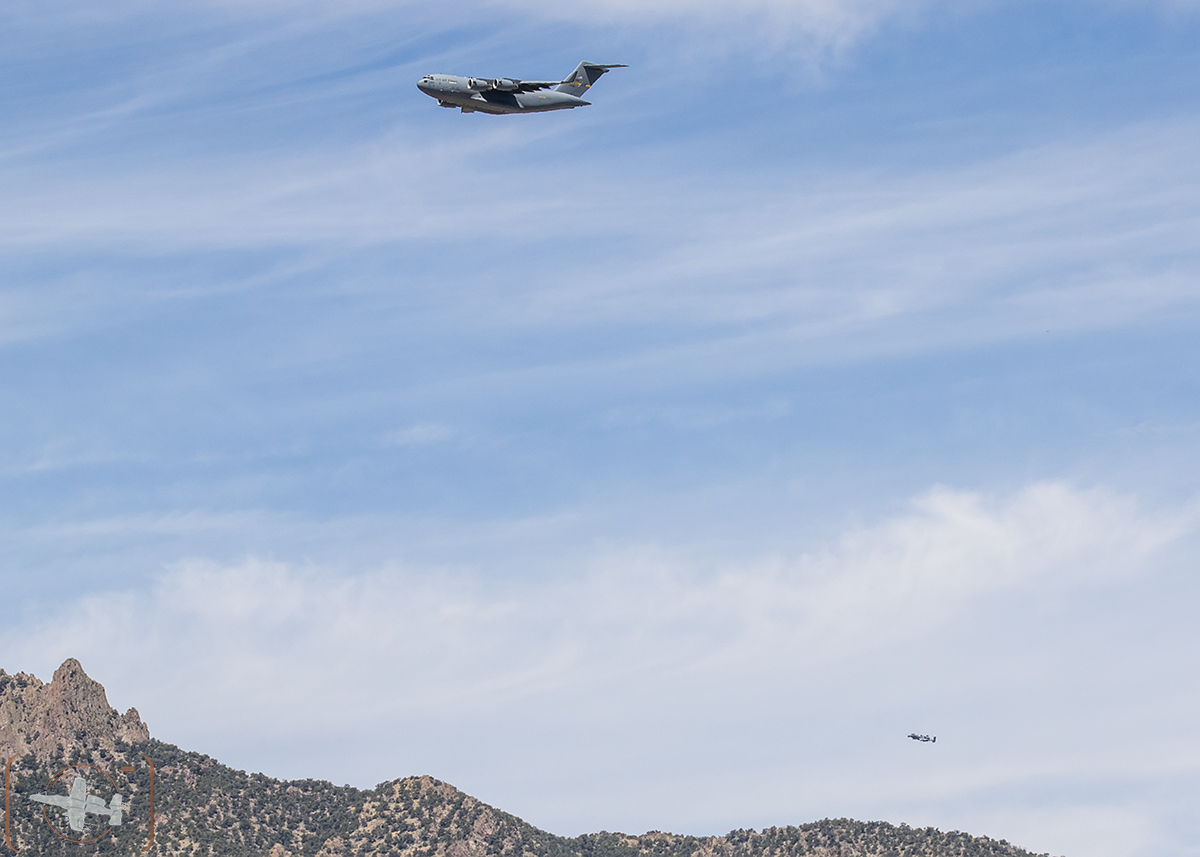
Air Mobility Command C-17A of the 437 AW/315 AW, Charleston, SC flies parallel Keno Airfield on the NTTR during Joint Forcible Entry Exercise (June 2016). An A-10C from the 66 WPS provides Close air support in the immediate vicinity of the airfield, neutralizing targets of opportunity.
Drowley speaks to the future training environment of the warfighter: “The A2/AD environment presents a tremendous amount of information that has to be collected, prioritized and then disseminated to the appropriate players so they can execute. As we look forward to the evolution of the Air force warrior, the capabilities that bring that information fusion will be a large part of it. This is the next evolution for weapons officers. In the early ninety’s they were masters of their combat specialty, now they’re integration experts, the next evolution they will be fusion experts when it comes to kinetic, non-kinetic effects, information and dissemination. That is the next step that we’re taking here at the weapons school, working towards that fusion expertise.
That’s the next evolution for the range and the adversaries in the training environment. Right now we have the kinetic range and the non-kinetic construct (range) over it (as we talk about live virtual construct and bringing more sims into play). Our capabilities are getting to the point where we want to be able to actuate the things that we would execute in combat in such a manner that it’s all integrated. If a non-kinetic effect impacts a surface to air missile, or impacts a target on range a kinetic player would see that impact. Right now there’s white space between those two ranges, that’s the next evolution for training, where kinetic and non-kinetic effects can be seen on the range. But that’s when we talk about LVC.”
Weapons Officers or Patch Wearers back in the “Force”
Weapons School students graduate shortly after JFEX and go back out into their squadrons having quite a high level of understanding. However, they also go back to their units with the Weapons School creed seared into their hearts and minds, Humble, Approachable, Credible. Col. Drowley strikes me as nothing less than living it. Absolutely humble, totally approachable, and without question, credible. It is understood that Weapons School graduates are entirely service oriented. As Drowley states, “Whenever I see another patch wearer (Weapons School graduate) out there, I know I’m about to run into another individual that espouses to being humble, approachable credible. They’re all service oriented. What can I do to make others better? What can I do to help out the fight? What can I do to get the job done? I don’t really care who gets the credit, I don’t really care about the glory of it, I’m just here to help out the fight and that’s really what it means to me.”
Reflecting back to his graduation from Weapons School Col. Drowley noted that he went immediately to the beginning of Operation Enduring Freedom (OEF), came back for a couple weeks to his squadron and then to the initial March 2003 wave of Operation Iraqi Freedom (OIF). Drowley found himself writing back to Weapons School what seemed like every day: “that one vul that I did in Weapons School – I saw it again in combat over here and it helped me lead this four ship. That one thing that you taught me at Weapons School, I taught it to these guys here and it saved them when a Roland shot at them.” A better warfighter, a better colleague, a better person. The outcome of Weapons School.
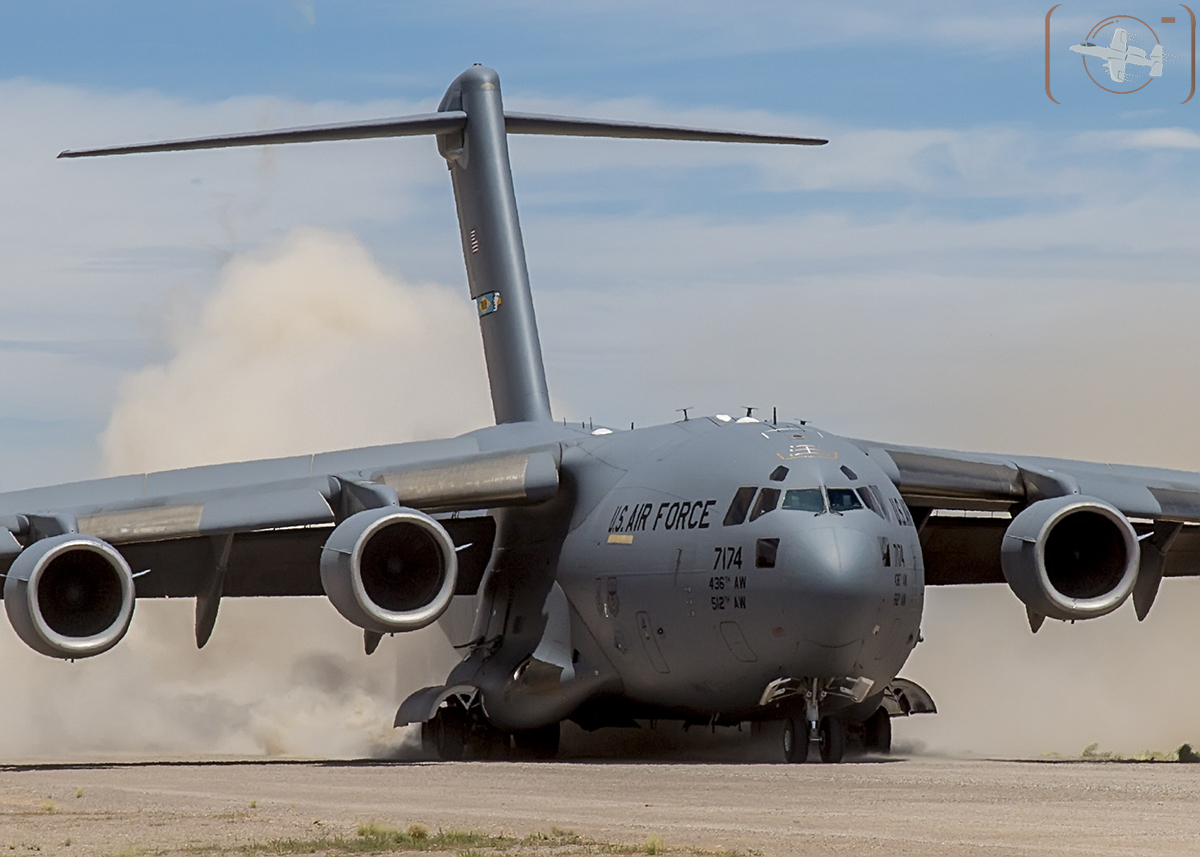
Air Mobility Command C-17A of the 436th Airlift Wing, Dover, DE kicks up the dust as it touches downs at Keno Airfield on the NTTR during Joint Forcible Entry Exercise (June 2016).
While it is an artificial argument to imply leadership development & realistic training is the most important priority, one must recognize the exponential value, the force multiplication provided by Weapons School outcomes, and the NTTR.
Cost to train an F-16 pilot – $6 Million
F-16 – $20 Million
NTTR & Weapons School – priceless.
A Force multiplier. The difference between success and failure. Of the highest priority.
There’s an incredible wealth to take away from the JFEX and the Weapons School experience:
- The need for the U.S. Military Forces to work Jointly, integrate capabilities to address current and evolving threats.
- Developing the best tactical warfighting leadership to multiply the effectiveness and success of the USAF.
- Evolving Training and Warfighting capabilities to address kinetic, non-kinetic, Cyber, Space, Electronic warfare as well as Information Fusion.
The Rewards of the Air Force Experience
The Air Force is a profession and Weapons School as the mastery of that profession.
Standeford reflects on his experience in the Air Force. “This is my fifth JFE vul. Just sitting in the briefing room and realizing what we’re capable of doing as a group when we all get together and put our heads down is so impressive. This is why I joined, because of the guy sitting next to me. You know he puts his life on the line for me, so I can put my life on the line for these 60 to 100 paratroopers in the back of the airplane so they can go do the dirty work. It is something bigger than you. There is a real brotherhood amongst each other when you are put in a stressful situation and you all come together to solve it.”
Standeford knows this brotherhood firsthand, and reflects on what was an impactful moment in his service. “It was the spring of 2011 on our deployment in the C-130. We were performing standard hops delivering cargo when we received the call to go pick-up a soldier who had fallen.
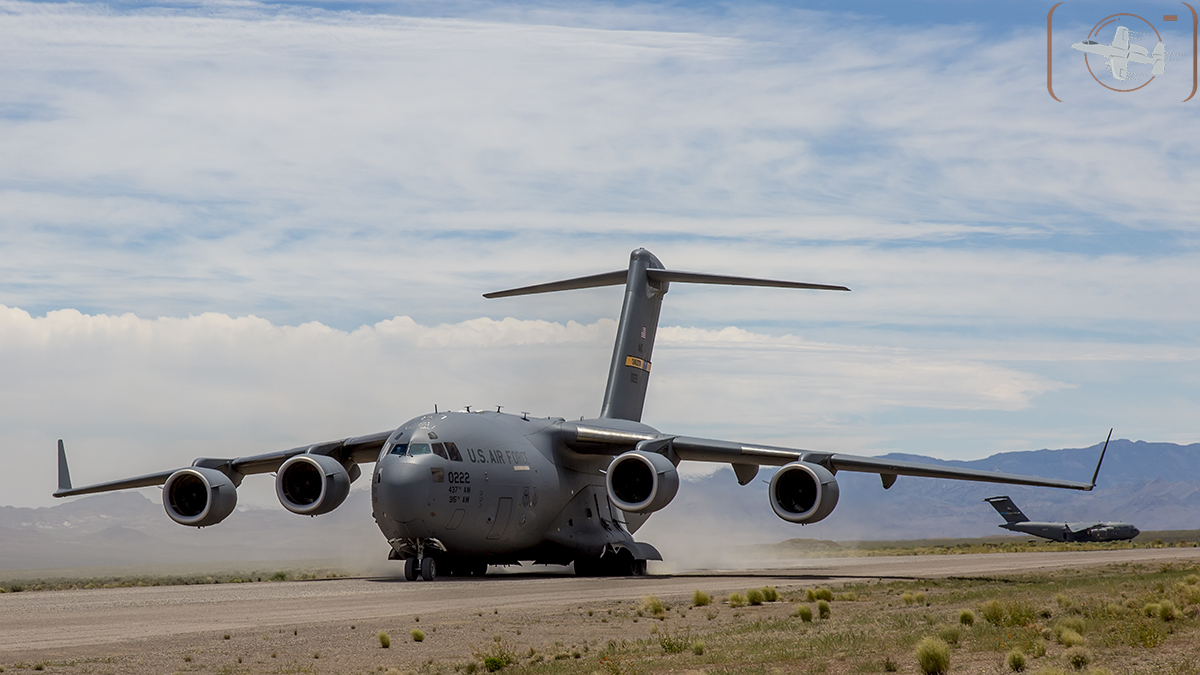
Air Mobility Command C-17A of the 437 AW/315 AW, Charleston, SC taxis at Keno Airfield on the NTTR during Joint Forcible Entry Exercise (June 2016). C-17A of the 436 AW/512 AW handles cargo in background.
It is very sobering when you land and the whole FOB (and this was a large FOB) is shut down and everybody was out on that ramp to watch that flag draped casket go by. The C-130 has only six pallet positions, but you look into that cargo hold and it is empty, save for a casket draped with an American flag. Now it is your job to get that soldier back to a base so they can move that soldier back to United States. It hit me, this is what we do. It goes back to watching all those soldiers at the FOB, you could see it in their faces, ‘this is one of our brothers.’ Then they hand it to us and now you have to get this soldier home so they can be with their family. It is humbling, and an honor to do that for them as well as their family.”
Exceptional people, professionals and leaders. JFE represents the imminent graduation of another class of Weapons School graduates, Advanced Integration Warfighters that will assimilate back into the broader Air Force. JFE was merely a scrimmage, and these new “patch wearers” will be the “go to” resource for planning complex and critical missions.
Photo contributions Todd Miller JFEX June 2016, and Eric Bowen from JFEX December 2015.
Click on an image below to page or swipe through the gallery:
Todd Miller resides in rural Maryland west of Baltimore. Given less than required eyesight Todd’s dreams of fighter pilot were grounded, but the love of military aviation has never subsided. Todd enjoys capturing military aircraft through photography, with a particular desire to capture them in mission action. When not busy chasing jets, Todd works in the area of Business Development for a prominent flooring materials company.
Todd can be reached at: [email protected]


